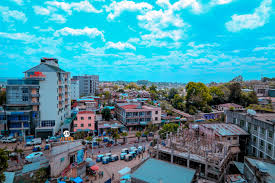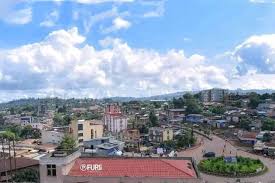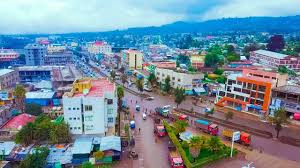Nekemte, a city located in western Ethiopia, is one of the most significant urban centers in the Oromia Region. It lies in the East Welega Zone and serves as both a commercial hub and a cultural heart for the surrounding areas. Situated at an elevation of 2,088 meters above sea level, Nekemte has grown in importance over the years due to its strategic location, rich history, and cultural significance.
Geography and Climate
Nekemte is nestled in a highland area with coordinates 9°5′N and 36°33′E. The city’s elevation gives it a mild subtropical highland climate (Köppen: Cwb), characterized by warm summers and mild winters. The climate is marked by heavy rainfall, particularly during the summer months. With an average annual precipitation of over 2,080 mm, it is among the rainiest cities in Ethiopia. Temperatures in Nekemte range from highs of 25.8°C in January to lows of around 11°C in the winter months. The combination of high rainfall and moderate temperatures makes the region ideal for agriculture, which is central to the economy of Nekemte and the surrounding areas.
Historical Background
Nekemte’s history is deeply intertwined with the Oromo people, particularly the Machaa Oromo subgroup, who have inhabited the region for centuries. The city grew out of the agricultural surpluses produced by these people after they became permanently settled in the late 16th century. The Gadaa system, an indigenous form of governance practiced by the Oromo, played a vital role in the development of Nekemte. This system, which involved the periodic transfer of leadership to a new age group, helped stabilize the region and foster economic growth.
The rise of Nekemte as a significant town occurred in the mid-19th century when Bekere Godana extended his influence over the region, establishing a new polity. His son, Moroda Bekere, solidified Nekemte’s importance by making it the capital of the Kingdom of Welega. Under the rule of Kumsa Moroda (later known as Gebregziabher Moroda after converting to Christianity), the city became a vital part of the Ethiopian Empire, particularly after submitting to the Shewan rulers.
Cultural Significance
Nekemte holds a special place in the cultural history of the Oromo people. It is home to a museum dedicated to the Machaa Oromo culture, which preserves and promotes the history and traditions of this important group. One of the city’s most famous sons is Onesimos Nesib, a prominent Oromo intellectual who translated the Bible into the Oromo language for the first time, in collaboration with Aster Ganno. His contributions to the preservation and development of the Oromo language and culture are still celebrated today.
The city is also the seat of an Apostolic Vicariate of the Roman Catholic Church, demonstrating its religious diversity. Ethiopian Orthodox Christianity is prominent in the region, as evidenced by the construction of an Ethiopian Orthodox church in the late 19th century, which was visited by the Russian explorer Alexander Bulatovich in 1897. Bulatovich’s detailed accounts of the city provide valuable insights into its vibrant marketplace and diverse population during that period.
Infrastructure and Development
Nekemte has played a crucial role in the development of western Ethiopia, particularly as a center for trade and transportation. The city is connected to the Ethiopian capital, Addis Ababa, by a road that dates back to the early 1930s. Though initially passable only by lorries, this road was a vital link between the interior of Ethiopia and the capital. The road network expanded further in the 1960s with the construction of a road connecting Nekemte to Gimbi, which became part of the Third Highway Program.
Postal service arrived in Nekemte as early as 1923, followed by the establishment of a branch of the Ethiopian Electric Light and Power Authority by 1960. By 1957, the city was connected to the national telephone network, further integrating it into the national infrastructure. These developments helped Nekemte become the most important town in the Welega province by the 1930s.
In terms of health care, Nekemte saw the construction of a hospital in 1927, which was completed in 1932 with financial support from Swedish sources and contributions from Ras Tafari, who would later become Emperor Haile Selassie. The hospital, which formally opened in February 1932, served as a key medical center for the region, and the Swedish missionaries who helped fund it played a significant role in the community.
World War II and the Italian Occupation
Nekemte’s strategic importance made it a target during the Italian invasion of Ethiopia in 1936. The city was bombed by Italian forces in July of that year, and Dejazmach Habte Maryam, the governor of Welega, eventually accepted Italian occupation. Colonel Marone, an Italian military officer, arrived in Nekemte by air in October 1936, while Italian troops reached the city after a grueling twelve-day march from Addis Alem. The Italian occupation severely weakened the local resistance, though Emperor Haile Selassie visited Nekemte in 1941 during his successful campaign to reclaim Ethiopia from the Italians.
Political Significance in the 20th Century
In the latter half of the 20th century, Nekemte continued to play a key role in Ethiopia’s political landscape. In 1979, Head of State Mengistu Haile Mariam visited the city as part of a formal tour. However, the Derg regime, under which Mengistu ruled, was not well-received by all, as evidenced by the imprisonment of over 300 Evangelical Christians for political reasons in that same year.
During the Ethiopian Civil War, Nekemte became a focal point for military activity. The Fourth Revolutionary Army, a key element of the Ethiopian government’s military forces, was headquartered in the city in the early 1990s. However, the Ethiopian People’s Revolutionary Democratic Front (EPRDF) captured Nekemte in April 1991 during Operation Freedom and Equality, signaling the end of the Derg regime.
Modern-Day Nekemte
Today, Nekemte is a rapidly growing city with a population of over 148,000 people as of 2021. The city is home to Wollega University, a major institution of higher learning in the region. Despite its growth, Nekemte retains much of its historical charm, with its bustling markets and rich cultural heritage.
The city is well-connected to the rest of Ethiopia by road, and though its airport is not currently open to commercial flights, plans for future development are in place. Nekemte is at the center of economic activity in western Ethiopia, with agriculture continuing to play a dominant role in the local economy.
Conclusion
Nekemte stands as a testament to Ethiopia’s complex history and rich cultural tapestry. From its origins as a center of the Oromo Gadaa system to its modern role as a commercial and educational hub, the city has remained an important part of Ethiopia’s national fabric. Its historical significance, cultural contributions, and strategic location ensure that Nekemte will continue to play a vital role in Ethiopia’s future.





